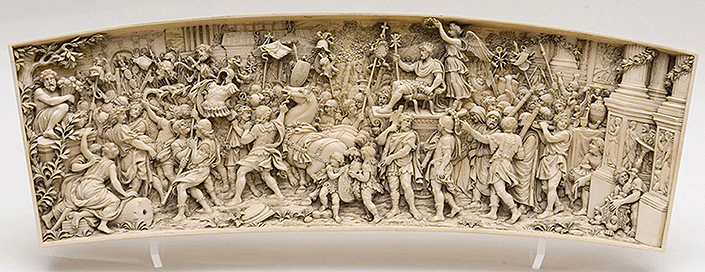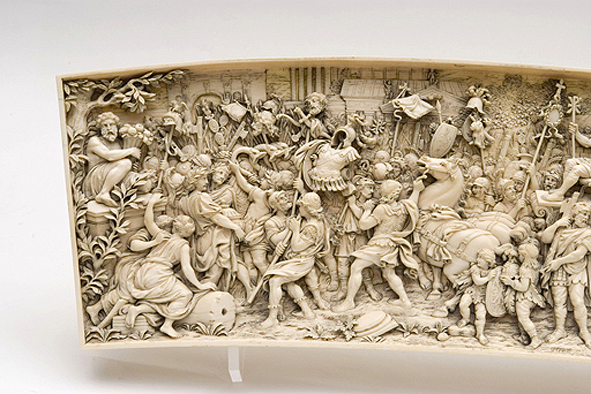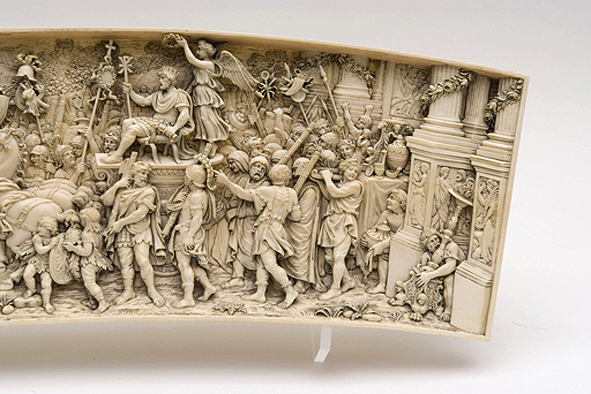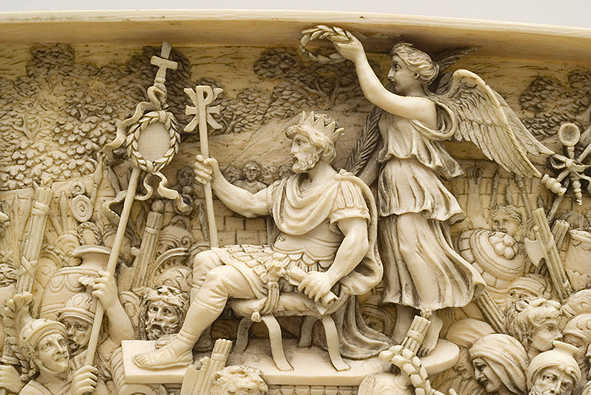The piece of the month of October 2008
TRIUMPHAL PROCESSION OF CONSTANTINE ON AN IVORY FROM THE MUSEUM OF NAVARRA
Francisco Javier Zubiaur Carreño
Curator. Museum of Navarra
(partner: Jesús Soria Magaña
scholarship recipient. Museum of Navarra)
Among the most beautiful objects preserved by the Museum of Navarre are two exceptional works made of ivory, the Hispano-Arabic chest of Leire, made by Faray and his disciples in the Cordovan workshop of Madinat-al-Zahira, around 1005 AD, and the bas-relief representing the triumphal entrance of Constantine the Great in the city of Rome in 312, after his victory over Maxentius, on October 28, near the Milvian Bridge, to which we will devote our attention.
It is an ivory plaque 42.3 to 48 cm. long, and between 14 and 15.1 cm. wide, from agreement to development curved tusk animal, most likely elephant, which presents a thickness of 1.6 cm. whose obverse has been decorated in bas-relief with the representation mentioned, presenting smooth the reverse except for a circular hole in each of the side edges that served in the past to expose the plate. The quality of the material is superior and the state of conservation of the whole is perfect.
It was donated to the Government of Navarre by order of Mr. Eliseo Belzunce Lizarraga, in Pamplona, which his children Mr. Fernando, Mrs. Isabel, Mr. Carlos and Mr. José Luis Belzunce Belzunce took care of on November 26, 1991. The donation was accepted by the Government of Navarre by agreement of March 16, 1992, and this invaluable work entered the funds of the Museum of Navarre (inventory number 2.493), in one of whose showcases it is permanently exhibited to the public.
Its origin is uncertain. We know from its donors that it was bought in an antique store in San Sebastian, now disappeared, in 1950. No other documentation has been preserved. This, together with the fact that the bas-relief is not signed, obliges us to carry out a detailed analysis of its iconographic and stylistic characteristics, if we wish to conclude a sure ascription of the piece in time and space.

Ivory plaque with scene of the triumphal parade of Constantine. Museum of Navarra
(Photo: Larrión & Pimoulier)
Typological characteristics
It belongs to the subject "plaquette" (less common than the "bulto redondo"), of frequent production between the second half of the XVI century and the dawn of the XIX century, when the representations in ivory began to yield to the skill of porcelain and daguerreotype. Because of the apparent nobility, the extraordinary fascination and attraction it produces, together with the exceptional technical qualities required by the executor, it has been a preferred object of collection by royal houses and European aristocracies, and the importation of its raw subject from the original points of Africa and Asia has been highly appreciated. In Western Europe, the ports of Dieppe and Rouen, at the mouth of the Seine, London, on the other side of the English Channel, the Tuscan city of Livorno, in Italy, Hamburg in Germany, Antwerp and Amsterdam in the Netherlands, have concentrated their trade, which supplied countless workshops, so that the variety of schools is immense, as well as the issue of their artisans. The Spanish and Portuguese also competed in the traffic of this precious material from their far eastern colonies. In the 18th century, the period of the maximum artistic splendor of ivory, manuals were published to learn how to carve it, such as those of Plumier, Doppelmayr and Teuber. The best artistic collections of this material are in the Louvre Museum, the British Museum, and the museums of Ravenna, Florence, Athens and Istanbul.
The art of eboraria has been inspired by other arts such as goldsmithing and medallistics, as well as engraving, of which the executor has often been a copyist, although, as ivory behaves in a very similar way to wood, the craftsman has followed a similar technical process, in terms of the previous phase of roughing and the subsequent carving, using, as is logical in the case of an almost miniature format, a smaller tool (saw, chisels and burins). Sometimes, the craftsman preferred to soak the ivory fragment to facilitate its modeling and, once finished, its polishing was achieved by rubbing it with a cloth.
From the scientific point of view, the art of eboraria is largely an unexplored art, poorly known, without too many bibliographical references, and therefore with few well identified works, even in Spain, where, since medieval times, fine representations have been produced on religious themes (Crucifixions), being those of profane subject matter frequently imported from the Italian, German, Flemish and Franche-Comté (Burgundy) schools, with eclectic stylistic characters, a mixture of Flemish, French and Italian. Apart from these imports, its own production received a boost from King Charles III when he appointed the Italian Andrea Pozzi director of the Ivory Workshop of the Buen Retiro (Madrid), in 1764. But the variety of iconographic themes, as Margarita Estella studies, is reduced, at least from the Baroque period.

Detail of the ivory plaque. Left half
(Photo: Larrión & Pimoulier)
Iconografía
No existe ninguna representación en eboraria del tema que nos ocupa en la conocida compilación de Tardy, ni siquiera del triunfo de ningún otro personaje imperial, si excluimos las existentes en piedra sobre los arcos de la antigua Roma, entre ellos el erigido en recuerdo de Constantino. En el recorrido realizado por los museos internacionales, sólo hemos topado con tres pinturas con la entrada triunfal de Constantino, todas ellas de estilo Barroco: una de Pedro Pablo Rubens, de h. 1621, sita en el Indianápolis Museum; otra atribuida al pintor napolitano Domenico Gargiulo, llamado Micco Spadaro, en el Museo Nacional del Prado, y una tercera pintada por René Antoine Houasse hacia 1672, en el Museo Nacional Palacio de Versalles. Todas las representaciones recogen los elementos esenciales de una iconografía establecida para exaltar el triunfo en la antigua Roma, el más alto honor militar que podía ser otorgado a un general victorioso en alguna empresa bélica.
El marfil del Museo de Navarra lo destaca en un formato que, por su longitud, favorece el desarrollo en secuencia ininterrumpida, narrativa, del acontecimiento, que es acotado por dos escenas en primer término: en la de la izquierda, tras dos muchachas entrelazadas que se apoyan en los tambores de sendas columnas caídas y, sobre un podio, en parte enmascarado por el árbol sagrado del dios Zeus, al que vemos barbado con el cuerno de la abundancia en sus manos respaldando al héroe, del que sabemos que, pese a favorecer la libertad de culto en el Imperio Romano y con ello al Cristianismo (Edicto de Milán, 313), no abandonó por completo su creencia en los dioses paganos hasta poco antes de convertirse al final de su vida; en el lado contrario, entre los pedestales del arco de triunfo por el que pasa el cortejo asoma un personaje barbado llevando otro símbolo de riqueza, un pebetero llameante con esfinges por patas y astil bulboso. La procesión militar ha entrado por una porta triunphalis, erigida a la memoria de un triunfo anterior, en un cierto desorden motivado por la exaltación del momento, y ha tomado la Via Sacra en dirección al Foro y el templo de Júpiter Capitolino; los edificios de la ciudad eterna constituyen el fondo de esta abigarrada sucesión de escenas, dejando ver entre sí trazas del campo y del paisaje que la rodea, como también algún lienzo de muralla. Es tan denso el grupo que abre la marcha, mayormente militar por la abundancia de insignias, estandartes, lábaros y lanzas que se enarbolan, entre ellas dos altas picas que exhiben las cabezas de dos vencidos en la batalla de Milvio (una de ellas seguramente la del opositor Majencio al que después de morir ahogado en el Tíber su cabeza le fue cortada), que solo es posible describir con más detalle si nos limitamos a los personajes de los dos primeros términos. Lejos de lo acostumbrado, la procesión triunfal no fue encabezada por jefes cautivos sino por senadores y hombres de jerarquía consular puestos en libertad tras la victoria de Constantino, representados en cabeza por hombres laureados de digna presencia, uno de ellos portando un vaso de perfumes. Tras ellos, los componentes de una banda de tocadores de trompetas que preceden a los legionarios que llevan los despojos humanos señalados y los trofeos arrebatados a los vencidos (casco y espada, loriga, el casco del general con su cetro, carcaj y otras armas). El séquito se ha acortado, dado que en la representación están ausentes los que a continuación –sacerdotes precedidos de flautistas- solían llevar un toro blanco destinado al sacrificio. Los prisioneros de guerra, que al término del desfile eran ejecutados, se han omitido. El mayor protagonismo, pues, lo recibe Constantino, que va en su carroza (no el currus triunphalis de sección circular, que era el apropiado, sino la tensa, especie de altar rodante destinado a las divinidades) tirado por cuatro corceles, el primero de ellos sujeto con dificultad por su palafrenero, tras cuya grupa van dos niños, seguramente los hijos menores del estratega, portando, uno, el yelmo plumífero y, otro, el escudo con el crismón, de su padre. El general victorioso va sentado en la silla curul, con coraza, manto, cetro en su mano derecha con el emblema de la Iglesia primitiva (letras griegas X y P sobrepuestas equivalentes a XPIΣΤΟΣ), de la que se convertiría en libertador, sobre cuya cabeza coronada la representación alada de la Victoria sostiene el laurel de la recompensa militar. En su mano izquierda, extendida, porta una carta enrollada, quizás la que, según Holsapple y Christensen, envió a Licinio y Maximino Daya antes del Edicto de Milán (febrero del 313), haciéndoles llegar prescripciones de tolerancia para los cristianos de Oriente. Se anteponen al carruaje y lo siguen varios lictores con sus fasces (en realidad el número total de los que contamos en el cortejo son diez), como funcionarios encargados de manifestar el imperium del personaje y de escoltarle, entremezclados con otros personajes que pudieran representar a la oficialía (tribuna militum) y a los embajadores (legati) o magistrados (magistrati). Tras el carro del héroe se suman a la marcha dos figuras femeninas, una de ellas seguramente Elena, madre de Constantino, que se representa de cierta edad, vestida cual matrona, a la que la leyenda atribuye haber descubierto la Vera Cruz. Finaliza el cortejo, aunque todavía parece continuar bajo el arco de triunfo, con porteadores laureados que llevan a hombros una rica mesa sobre cuya encimera hay depositados distintos objetos aprehendidos al enemigo vencido.

Detail of the ivory plaque. Right half
(Photo: Larrión & Pimoulier)
The whole set, which has an air of deifying apotheosis of the new emperor of the West, presents the added value of serving as a document, quite faithful, of such military honors, decreed by the Senate in favor of the one who had inflicted on the adversary up to 5,000 casualties in a single action and had been acclaimed as Caesar by his own troops. It is test that the artist knew well the culture of ancient Rome to the point of describing in detail, not only the triumph itself and the characters involved in it, but the costumes and all the props of the great representation. The wavy hair topped in a bun of the maidens (which follows the fashion of the wife of framework Aurelius Faustina the Younger), in stark contrast to the veiled head of Elena, typical of a widowed woman; the bearded faces of the men, including that of Constatino, who shaved it once acclaimed emperor; all possible clothing (some garments such as tights denotes contact with the barbarian world), including the harnesses of the main horse; the footwear; the uniforms and weapons; the emblems; the musical instruments; the vases and vases; the reliefs on public buildings; the archaeological remains fallen to the ground, and even the grass and pebbles on the ground, all speak of a credible and true reconstruction, which places the executor in a historical period of revaluation of the classical past.
Formal and stylistic analysis
The variegated composition of the plaque is forced to adapt to framework with a horror vacui that continues a tradition emanating from classical reliefs such as those that decorate with fights of Romans against barbarians the sarcophagi of Portonaccio (ca. 190 A.D., Rome, Museo Nazionale Romano di Palazzo Maximo alle Terme) and Ludovisi (ca. 260 A.D., Rome, Museo Nazionale di Palazzo Altemps), but without reaching the extreme of those of generating a sensation of disordered mass among the elements represented. The ivory of the Museum of Navarra contains in its 57.40 cm² 189 diverse elements among men, animals, objects, trees and buildings, nevertheless the composition of the set is orderly in its variety, since the characters, although they turn or swirl, follow as group a directional movement of right-left advance. This marching sensation is further emphasized by the asymmetrical composition of the ensemble and by a movement that affects banners, lances, legs, twisted postures and cloths equally agitated by the dynamics generated. In the organization of the sculpted group , the figure of the emperor, slightly off-center to the right, marks the hierarchical center not only by his position but also by his elevation and attire, and also establishes two ways of representing within a dominant, softly idealized realism (reinforced by the apparent "softness" of the ivory). On the left, motor side, the effect of asymmetry with respect to the opposite, more leisurely side, is based on fronto-lateral dispositions, profiles, opposite movements, colloquial attitudes, and foreshortenings, which accentuate the sensation of surprised movement. In the same way, the folds of the dresses have been treated in depth, seeking to highlight their Issue and the effects of chiaroscuro, to achieve which the bodies have a maximum relief of 1.5 cm. and in perspective we can specify up to thirteen successive planes. This feeling of vitality, translated with Baroque resources, is opposed to a sensation of serenity dominant in the procession on the right side, with a slow, solemn movement, as befits the dignity of the characters here, no longer soldiers in turmoil. In spite of the intense moment lived, the expression of the faces is calm, not expressive or dramatic in the baroque or romantic way, but serene, of neoclassical style.

Detail of the ivory plaque. Constantine crowned by the Victory
(Photo: Larrión & Pimoulier)
This piece can well be placed within a late baroque style in contact with the neoclassicism that opens its way in an evident way. First, with its moralizing intention expressed through the exaltation of Constantine no longer as a hero but as a guarantor of freedom of worship. He is, therefore, a magnanimous victor, although the victory is evident by the decapitated heads and the booty obtained, in any case attributed by the artist to the soldiers who precede the procession. On the other hand, the nervous modeling that in the rococo gave surfaces of sensual textures, is sacrificed in this plate in favor of well marked contours that serve to highlight from the background the different lumps, in a very visual sensation but not as effective as in the baroque, although, as it has been commented, it is the heading of the parade that is more baroque in the treatment of the space. From the compositional point of view, the representation is adapted to the framework as in the classical world the figures were subordinated to the pediment of the temples. The material preferred by the neoclassical sculptors was marble, since it guaranteed a technique of animation based on the study of the figure in its natural state. Similarly, ivory, with its homogeneous coloring and smooth texture, also allows the ideal to be expressed with financial aid of a light that is diffused. Similarly, both materials require a refined and demanding technique, which is demonstrated here in the treatment of the musculature of the bodies and in the drapery of the clothing.

Detail of the ivory plaque. Soldiers carrying trophies
(Photo: Larrión & Pimoulier)
Such intimately shared characteristics show that the chronology of this bas-relief is difficult to specify, since neoclassicism did not set a limit to certain compositions and spatial treatments, and the admiration for the classical world (glorification of historical facts and figures) would last until romanticism. It will be the iconographic-stylistic parallels that will help to ascribe the piece. In spite of the differentiating nuances, the ivory of the Museum of Navarre evokes the homonymous painting of the baroque painter Domenico Gargiulo (1610-1675), author also of a "Triumph of Vespasian", both in the Museo Nacional del Prado, although in that one the representation appears inverted and the perspective is, logically in a painting, aerial. The soft modeling of the ivory and, in particular, the adherence of the draperies to the bodies, leaving their Anatomy, can be related to the art of the sculptor Antonio Canova and his Roman circle, whose influences persist in neoclassicism and reach Spain, to the centers of Barcelona (Damian Campeny) and Madrid (José Álvarez Cubero, "the Spanish Canova"). The elegance and certain grace of the ivory bas-relief of the Museum of Navarre also seem to be of Italian origin. Furthermore, the candelabrum that in an anecdotal scene is carried by the figure in the lower right corner of the ivory is similar to a subject described by Montgau in the Roman Baroque church of Santo Spiritu in Sassia, decorated at its base with unusual figures of sphinxes, which this author relates to a series of designs made by Domenichino (1581-1641) for Windsor Castle (Royal Library of the United Kingdom).
Therefore, we are inclined to think that the ivory "entrance of Constantine in Rome", from the Museum of Navarre, is a work attributable to an early neoclassicism (ca. 1750) influenced by the Italian art of the time, which is not unrelated to a survival of the Baroque in the Age of Enlightenment.
bibliography
CHRISTENSEN, T., "The so-called Edict of Milan", Classica et Medievalia, University of Aarhus (Denmark), 35 (1984), pp. 129-175.
DOPPELMAYR, J. G., Historische Nachricht, Nuremberg, 1730.
ESTELLA, M., La escultura barroca de marfil en España, escuelas españolas y coloniales, Madrid, high school Diego Velásquez del C.S.I.C., 1984.
ID. "Ivory sculpture in Spain, delicate forms of a millenary art", Antiqvaria, VII, 1989, no. 63, pp. 42-52.
EUSEBIO DE CESAREA, Vida de Constantino, Madrid, Gredos, 1994 (reed.), chap. I, pp. 27-32.
HOLSAPPLE, LL. B., Constantine the Great, Buenos Aires, Espasa-Calpe Argentina, 1947, chapter VI.
MARCOS, M., "La idea de libertad religiosa en el Imperio romano", Ilu, Revista de Ciencias de las Religiones, Madrid, Universidad Complutense, XVIII, 2007, pp. 61-81.
MONTGAU, J., La scultura barroca romana. Un'industria dell'arte, Torino, Humberto Allemandi, 1991, pp. 49-51.
PLUMIER, C., L'Art du tourner, Lyon, 1701.
TARDY, Les ivoires, évolution décorative du Ier. siècle à nos jours, Paris, Tardy, 1966.
TEUBER, J.M., Vollständiger Unterricht, Regensburg, 1740.
